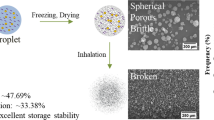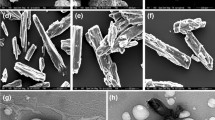Abstract
The purpose of the study was to prepare stable liposomally entrapped budesonide (BUD) for a dry powder inhaler (DPI) formulation. BUD liposomes composed of egg phosphatidyl choline and cholesterol were prepared by lipid film hydration technique and sonicated to have the desired size (<5 μm). A rapid method was used for separation of free drug by centrifugation at a lower centrifugal force (G value). Liposomal dispersion was subjected to lyophilization after blending BUD with cryoprotectant in varying bulk and mass ratios, and percent drug remaining entrapped after lyophilization was optimized. Comparative drug retention studies on storage of DPI formulations were carried out in accordance with International Conference on Harmonization guidelines. Critical relative humidity of the formulations was determined and reported as one of the manufacturing controls. Sucrose was found to be the most effective cryoprotectant when present on both sides of the lamellae of liposomes in a bulk strength of 500 mM and mass ratio of lipid:sugar; 1∶10. Blending of sorbolac before lyophilization showed better retention of encapsulated drug (95.59%). The respirable fraction of the product (20.69±1.50%) was comparable with that of the control (26.49±1.52%), suggesting that the liposomal BUD can be successfully delivered throughout the broncho-pulmonary tree. The findings demonstrate that liposome of BUD can be prepared with a high entrapment value, stabilized by lyophilization, and delivered as an aerosolized DPI. The stability studies of lyophilized product suggests a shelf-life of one year when stored under refrigeration (2°C–8°C).
Similar content being viewed by others
References
Crowe LM, Crowe JH. Solution effects on the thermotropic phase transition of unilamellar liposomes. Biochim Biophys Acta. 1991; 1064:267–274.
van Winden EC, Zhang W, Crommelin DJ. Effects of freezing rate on the stability of liposomes during freeze-drying and rehydration. Pharm Res. 1997; 14:1151–1160.
Bendas G, Schubert K, Nuhn P. Use of merocyanine 540 for the fluorimetric detection of liposome membrane properties before and after lyophilization and rehydration. Pharmazie. 1998; 53:43–46.
Juliano RL, Daoud SS. Liposomes as delivery system for membrane active anti-tumour drugs. J Control Rel. 1990; 11:225–232.
Faouzi MA, Dine T, Luyndex M, et al. High performance liquid chromatographic methods for the determination of budesonide in broncho alveolar lavage of asthmatic patients. J Chromatogr B Biomed Appl. 1995; 664:463–467.
Fry DW, White C, Goldman DJ. Rapid separation of low molecular weight solutes from liposomes without dilution. Anal Biochim. 1978; 90:809–815.
Rosier RN, Gunter TE, Tucker DA, Gunter KK. A rapid method for separating small vesicles from suspension. Anal Biochim. 1979; 96:384–390.
Stewart M, Charles J. Colorimetric determination of phospholipids with ammonium ferrothiocynate. Anal Biochim. 1980; 104:10–14.
Goel BK. Medical Laboratory Technology. Vol. III. New Delhi, India, Tata McGraw-Hill; 1988:1031.
Betagiri JV, Jenkins SA, Parsons DL. Liposomes Drug Delivery System. Lanchaster, Basel, Switzerland: Technomic Publishing Co Inc; 1993:120.
Campen LV, Zografi G. Moisture sorption kinetics for water-soluble substances. J Pharm Sci. 1983; 72:1381–1398.
Merk Index, 11th ed. New Jersey Merck & Co Inc, 1989, MISC-109.
British Pharmacopoeia, vol. 2. Appendix 17C. London, UK: Her Majesty's Stationery Office; 1988:A204.
Singh S. Drug stability testing and shelf life determination according to international guidelines. Pharm Tech. 1999; 23:68–86.
Hino T, Serigano T, Yamamoto H, Takeuchi H, Niwa T, Kawashima Y. Particle design of wogon extract dry powder for inhalation aerosols with granulation method. Int J Pharm. 1998; 168:59–68.
Martonen TB, Katz IM. Deposition pattern of aerosolized drugs within the human lung. Pharm Res. 1993; 10:871–878.
Crowe JH, Crowe LM. Factors affecting the stability of dry liposomes. Biochim Biophys Acta. 1988; 939:327–334.
Cullis PR, Hope MJ, Bally MB, Madden TD, Schieren HP, Janoff AS. Protection of large unilamellar vesicles by trehalose during dehydration: retention of vesicle content. Biochim Biophys Acta. 1985; 817:67–74.
Cullis PR, Hope MJ, Bally MB, Madden TD, Mayer LD, Janoff AS. Liposomes as pharmaceuticals. In Ostro MJ, ed. Liposomes from Biophysics to Therapeutics. New York: Marcel Dekker; 1987:39.
Blaurock AE. Evidence of bilayer structure and of membrane interactions from x-ray diffraction analysis. Biochim Biophys Acta. 1982; 650:167–207.
Grit M, Underberg WJM, Crommelin DJA. Hydrolysis of saturated soyabean phosphatidylcholine in aqueous liposome dispersion. J Pharm Sci. 1993; 82:362–366.
Amidon GE. Mechanical characterization of powders. In: Physical characterization of pharmaceutical solids, Brittain HG, eds., New York: Marcel Dekker; 1995:286.
Niven RW, Lott FD, Ip AY, Somaratne KD, Kearney M. Development and use of an in vitro system to evaluate inhaler devices. Int J Pharm. 1994; 101:81–87.
Braun MA, Oschmann R, Schmidt PC. Influence of excipients and storage humidity on the deposition of disodium cromoglycate (DSCG) in the twin impinger. Int J Pharm. 1996; 135:53–62.
Patel VB, Misra AN. Encapsulation and stability of clofazimine liposomes. J Microencapsulation. 1999; 16:357–367.
Ruijgrok EJ, Vulto AG, Van Etten EWM. Aerosol delivery of amphotericin B desoxycholate (Fungizone) and liposomal amphotericin B (AmBisome): aerosol characteristics and in-vivo amhotericin B deposition in rats. J Pharm Pharmacol. 2000; 52:619–627.
Sachettli S, Beaulac C, Riffon R, Lagace G. Evaluation of the pulmonary and the systemic immunogenicity of fluidosomes, a fluid liposomal-tobramycin formulation for the treatment of chronic infections in lungs. Biochim Biophys Acta. 1999; 1428:334–340.
Author information
Authors and Affiliations
Corresponding author
Additional information
Published: November 30, 2001
Rights and permissions
About this article
Cite this article
Joshi, M.R., Misra, A. Liposomal budesonide for dry powder inhaler: Preparation and stabilization. AAPS PharmSciTech 2, 25 (2001). https://doi.org/10.1208/pt020425
Received:
Accepted:
Published:
DOI: https://doi.org/10.1208/pt020425




